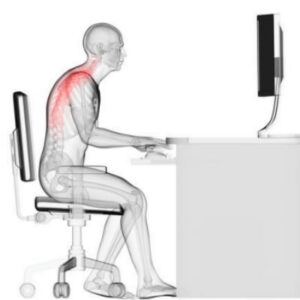

Tension and forward head posture (FHP) are more interconnected than you might think.
If you have been struggling with chronic neck pain, stiffness, or even tension headaches, chances are that tension might be at the root of your problem.
Forward head posture is one of the most common postural issues today, particularly for those glued to screens, but muscle tension from stress or repetitive habits is a key factor that is often overlooked.
In this article, we would uncover how tension contributes to FHP, dissect the mechanics behind it, and discuss scientifically backed ways to correct it.
In this Article:
- Understanding Forward Head Posture
- How Tension Builds and Sustains FHP
- The Science Behind Muscle Tension and Posture
- Emotional Stress: A Silent Contributor to Poor Posture
- Physical vs. Emotional Tension: Their Combined Impact on FHP
- Corrective Strategies for Tension-Induced FHP
- Conclusion: The Critical Role of Tension in Forward Head Posture
A Quick Look at Text Neck
Forward head posture occurs when the head protrudes ahead of the shoulders rather than resting directly over them. In a neutral spine position, the ears should align with the shoulders.
For every inch your head moves forward, the pressure on your neck increases significantly—roughly 10 pounds of extra load on the cervical spine per inch.
This leads to musculoskeletal strain, particularly in the neck, upper back, and shoulders.
While FHP is often attributed to poor ergonomics or excessive screen use, the role of tension, especially chronic tension, is a significant yet underexplored factor in FHP.
Chronic tension tightens muscles like the trapezius, levator scapulae, and the suboccipital group, pulling the head forward into an unnatural position.
How Tension Builds and Sustains FHP?
Tension, whether physical or emotional, accumulates in specific muscle groups, particularly in the neck and upper shoulders.
This creates a snowball effect—tense muscles become shortened and stiff, which in turn disrupts the muscle balance necessary to keep the head properly aligned.
Over time, this muscle imbalance becomes habitual, manifesting as forward head posture.
One major contributor to this is stress.
When you are tense, your body reacts by tightening muscles. It is a natural response meant for short bursts of action (the fight-or-flight mechanism), but when tension becomes chronic, it impacts posture by holding the muscles in a semi-permanent state of contraction..
The Science Behind Muscle Tension and Posture
The mechanics of muscle tension reveal why it so easily translates into FHP. When muscles are under constant tension, they shorten and lose flexibility.
The suboccipital muscles, in particular, become overly tight during FHP. These muscles are located at the base of the skull and connect to the cervical spine, and their role in stabilizing the head is crucial.
Studies show that people with forward head posture have higher levels of tension in these muscles compared to those with neutral head posture.
An electromyographic (EMG) study noted that individuals with FHP exhibited up to 42% more muscle activation in the suboccipital muscles compared to people without postural issues.
Moreover, tension in the sternocleidomastoid (SCM) and upper trapezius muscles contributes to a forward pull of the head, forcing the deep neck flexors to weaken.
As these muscles weaken, they are less capable of supporting the head’s weight, exacerbating the forward tilt and increasing tension even further.
Emotional Stress: A Silent Contributor to Poor Posture
Emotional stress is a massive but silent contributor to FHP.
Research shows that emotional tension has a direct impact on muscle tension, often leading to poor posture.
When you are anxious or stressed, you may unconsciously shrug your shoulders or clench your jaw, which pulls the head forward. This repetitive stress-induced tension reinforces bad postural habits.
Emotional stress also activates the body’s fight-or-flight response, leading to muscle contractions even when no physical threat is present.
The upper trapezius muscles, in particular, are vulnerable to stress-related contractions, which further pull the head forward.
Physical vs. Emotional Tension: Their Combined Impact on FHP
Physical tension from poor ergonomics or repetitive tasks can combine with emotional tension, making FHP a complex postural issue to resolve.
Prolonged use of screens or sitting in a slouched position causes physical tension, while emotional stress can lead to chronic tightening of the neck and shoulder muscles.
For example, someone who sits at a desk for hours may not only experience muscle fatigue from the physical strain but also deal with stress-related tension, compounding the problem.
The longer the posture remains unchecked, the more ingrained the muscle tension becomes, resulting in a chronic FHP.
Corrective Strategies for Tension-Induced FHP
Fortunately, forward head posture caused by tension is reversible.
Here is a scientifically backed approach:
Stretching Tight Muscles:
Focusing on stretching the tight muscles around the neck and upper back can reduce tension. Stretch the upper trapezius, sternocleidomastoid, and pectoral muscles regularly. A simple stretch like the doorway pec stretch can help release tension in the chest muscles, allowing the shoulders to retract and the head to move back into alignment.
Strengthening Weak Muscles:
Targeting weakened muscles is just as important. Strengthening the deep neck flexors with exercises like chin tucks can restore the balance between the front and back neck muscles, helping to pull the head back into place.
Posture Awareness:
Frequent posture checks throughout the day can help reverse FHP. Set reminders to correct your posture by aligning your head over your shoulders and tucking your chin slightly.
Stress Management Techniques:
Since emotional stress plays a significant role in muscle tension, it is essential to incorporate relaxation techniques into your routine.
Practices like diaphragmatic breathing, yoga, and meditation can help reduce overall muscle tension.
Ergonomic Adjustments:
Your work environment should support proper posture. Make sure your computer screen is at eye level and that your chair provides good lumbar support.
Adjusting the height of your desk and chair to ensure your arms are parallel to the floor can also reduce tension on the neck and shoulders.
The Critical Role of Tension in Forward Head Posture
In summary, tension—whether physical or emotional—is a significant factor that fuels forward head posture.
By understanding how stress and tension affect muscle behavior and disrupt postural alignment, we can take proactive steps to correct the issue.
From managing emotional stress to stretching and strengthening targeted muscles, the road to correcting FHP is a multi-faceted approach that addresses the underlying causes of tension.
The key takeaway is that FHP is not just about poor ergonomics or screen time; it is also about how we carry tension in our bodies.
Recognizing this link allows for more effective solutions to not just correct nerd neck but to prevent it from recurring.
References:


